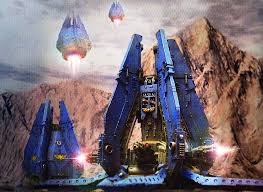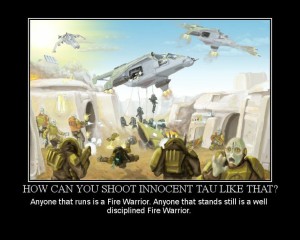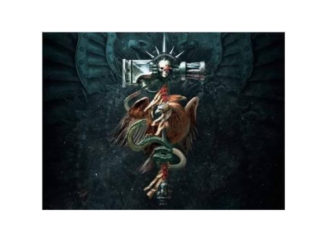
Hello, John (Overwatch) from captureandcontrol.com here to talk to you today about army/list design , specifically the Null Deploy army.
Army design and play style in 40k is a complex and varied landscape. On the surface it looks like there are three basic army builds and play styles into which all other builds can be placed.
Shooting armies are lists which center around the shooting phase for achieving victory (Tau comes to mind). These armies vary from gunline (static) or mobile (dynamic), but they achieve victory through killing enemy units at range.
Assault armies, or lists, are rarer than they had been in the days of yore (3rd4th edition), but a few armies like Khorne Daemonkin (KDK) and Space Wolves (SW) can pull it off. Often times, an Assault based army will have one of the vaunted “Deathstar” units in it.
Objective armies are generally built off the idea that scoring the objectives is the easiest path to victory. Fast moving, somewhat durable units that can camp or steal objectives as needed throughout a game make for good Objective Armies. They can also be “tank” armies or “horde” armies designed to win the game through attrition while simply scoring objectives and outlasting you. Lists who have large numbers of Objective Secured units make great Horde or “tank” armies.
Most armies fall into these three categories which makes them broad enough to be used as the general guidelines. Defining builds this way is essential for new players as is describing list building archetypes to new through moderate players. Inside these 3 basic designs, you find the real flavor and full fauna of the 40k game. Tired of the anecdotes yet? Too bad you’ll find plenty more in all my articles.
Let’s keep move on down the Inside the three list archetypes you can find a plethora of other builds. The Objective army is currently the most popular army build with multiple iterations. Daemon Farm, Battle Company (see the comment above about Objective Secured units), Eldar Biker Spam, and Necron Reclamation Legion, or Lychstar, are a few examples. The thing that makes the Objective armies popular is they are usually a combination army of the Objective list plus one of the other big two (Shooting/Assault). Besides the big three, armies usually have secondary attributes or traits they build upon. This can be “tank” or survivability traits: Necron Rec Legion, Chaos Renegades with their recycled units for example. High Mobility is a common secondary trait in Eldar and Tau builds. Horde is a much more common secondary army build trait now that Space Marines, the most popular army, now have access to the Battle Company, which allows them to put an obscene number of units and models with Objective Secured (Obsec) on the table. Yet another secondary trait is Psychic heavy armies, like Space Marines with Conclave or Daemons. The last secondary list trait I want to discuss today is the one that’s the focus of this article and probably the least popular of the others listed above. Null Deploy.
A Null Depoy army is one in which the player has their entire army in reserve, hence Null Deploy, and a large portion of that force shows up on turn 1. Most commonly this is a Space Marine army. Any Chapter can pull it off, even Grey Knights, so you are most likely going to see a Space Marine player utilizing this secondary list building trait. Forge World Elysians (stupid Danny) can pull this off as well. Playing a Null Deploy army seems like it would be a lot easier than a regular army at first. A null deploy player can find themselves in the following mindset: “I don’t need to worry about deployment, I get to come in wherever I want so who cares where objectives go. No need to be too concerned with my opponent’s deployment or what they do because I get to do what I want, go first/second who cares, defining terrain or placement of It, meh no concern of mine”.
A lot of that might ring true to you if you’re thinking of it from the perspective of a Drop Pod Space Marine army that is insulated from Deep Strike mishaps by the Inertial Guidance rules for the Drop Pods and almost everything in your army is ObSec. All of those thoughts about null deploy are wrong. I’ve been playing a null deploy Space Marine army of one Chapter or another since mid-way through 6th and all of 7th edition. While I routinely make jokes like “Wait, how do I deploy these scouts from the 10th company formation? You mean I can’t just put them anywhere on the board? What is this deployment you speak of” etc. They are just that, jokes, because playing a Null Deploy army is a challenge.
Let’s take a look first at one of my “typical” Null Deploy Space Marine lists, so we have a frame of reference for our discussion.
Ultramarines Gladius Strike Force
Battle Company
Captain
Chaplain
4x 5 Tactical Marines, Meltagun, Drop Pod
2x 5 Tactical Marines, Flamer, Drop Pod
5 Devastators 4x GravCannons Drop Pod
5 Devastators 4x Heavy Bolters Drop Pod
2x Land Speeders
1st Company Task Force
5 Sternguard, 2x Heavy Flamers, Drop Pod
5 Sternguard, 2x Meltaguns, Drop Pod
5 Sternguard, 2x Meltaguns, Drop Pod
Librarius Conclave
Tigurius (Warlord)
Librarian
Librarian
1850 73 Models 11 Drop Pods, 6 turn one.
The Null Deploy army design shares some characteristics across the build no matter the chapter chosen. It’s usually Drop Pod heavy (duh) and lacks mobility. Sure, you may have a build that has some outflanking Rhinos/Razorbacks, or maybe you chose bikes or possibly speeders to differentiate your null deploy Battle Company from everyone else’s, but generally, you’re looking at 6-11 Drop Pods. This means that things like Objective placement and terrain matter a lot. Once dropped in, those marines need to hoof it on foot to get where they need to go. If your mobile units are just a few bikes or speeders, a savvy opponent will eliminate those first and keep you walking/running all game while he guns you down.
Along with objective placement, keeping track of your opponents’ deployment and their reserves is essential. There is nothing worse than dropping in your Centurion Star (CentStar) on the top of Turn 1 only to realize your opponent is going to drop their CentStar right after you and blow your CentStar into nothingness. I mean, it’s not like this happened to me at the 2015 BAO and kept me from the top 8, or that Travis/Adam/Danny won’t shut up about it or anything. Playing a Null Deploy army does not mean you get to just sit back and not care about what’s going on before your turn 1. If you do, your opponents will simply trick you into dropping in where they want you to drop, which will be far from the objectives or in a spot that’s perfect for them to counter attack on their turn.
Null Deploy armies do have one distinct advantage. Against all armies (except Tau), they are excellent alpha strike lists. If you can fit in some heavy hitters, like the list above, coupled with some leadership shenanigans, like the list above, you can create some very effective headaches for an opponent who is susceptible to morale and small arms fire. Even just the Gravastators with the Sternguard makes for a hard one-two alpha punch, adding in Doctrines and psychic shenanigans just makes it that much more difficult for your opponent.
–
There are three primary concerns for you, if you’re thinking of running a Null Depoy list: target priority, list fluency, and prior knowledge. Your list will more than likely have a big Alpha strike punch, making sure that punch lands where it does the most damage is important. This is also where prior knowledge and list fluency comes in. No list needs more practice and prep than a Null Deploy army list. Being fluent with your list, the rules of your opponent’s army, and understanding target priority are of major importance for a Null Deploy list. If you come down against a list with a glass jaw and punch for the gut, or you go for the iron jaw of a list with a soft midsection, you’re going to have a bad time. The only way to properly hit your opponent where it hurts the most is to practice and study. You need to know if you go for the glass jaw of the single Knight in the list or the soft underbelly of 4 jetbike units. Do you go for the Quad mortars in the corner or the Centurions camping the Emperor’s Will objective? Do you try to Gravastate the Stormsurge or the Riptide Wing? Throat or extremities? Objectives or kill units? Warlord or Line Breaker plus King of the Hill? Knowing what your list can and cannot achieve means you’ll never ask it to do something it can’t. Once the army has dropped and you go to work, making the wrong initial decision can cripple your ability to win the game.
Null Deploy is often viewed as a hammer list or an Alpha Striking/shooting list, which it is. What is less well known, or often simply forgotten, is the Null Deploy style lists are a type of finesse list. Yes, you may be smacking your opponent first turn with the tightly bound ceramite fist of the Emperor’s finest, but after that, most of them die like Space Marines from the game, rather than stand tall like the Marines from the fluff. Utilizing terrain, placing the objectives where you can get to them while still being able to go after your opponent, choosing units that can hit and stand fast, bringing in countermeasures to other popular lists, and being aware of the Meta, Mission, and Minutia of the rules and units in the game are all of magnified importance to an army built around the Null Deploy tactic. When done right, the Null Deploy army can be unnerving to your opponent, but when played incorrectly, it blows over like a house of cards in a stiff breeze.
See you on the table top.






